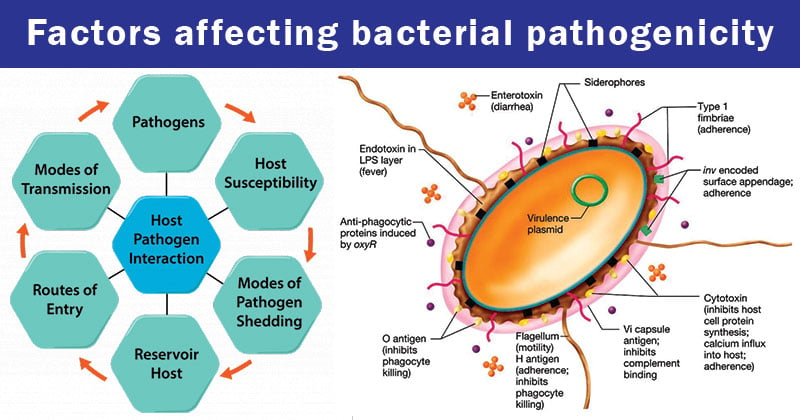Biology - Factors Affecting Infection Factors Affecting Infection A bacterial culture grown in a hospital pathology lab to identify pathogens in a patient blood sample Many factors combine to determine whether a pathogen will cause an infection in its host. An opportunistic pathogen by contrast can only cause disease in situations that compromise the hosts defenses such as the bodys protective barriers immune system or normal microbiota.

Factors Influencing Airborne Disease Transmission In Transport Download Scientific Diagram
We are studying Bacillus anthracis which causes anthrax infection a potentially lethal infectious disease.

. FACTORS AFFECTING RESISTANCE TO INFECTION. Their effects on the spread of pathogens are discussed elsewhere p. Invasion involves the dissemination of a pathogen throughout local tissues or the body.
This is a preview of subscription content log in to. Virulence factors contribute to a pathogens ability to cause disease. I have suggested that infectious disease emergence can be viewed operationally as a two-step process.
Abstract - Figures Preview. Bacterial toxins include endotoxin and exotoxins. Bacterial Exoenzymes and Toxins as Virulence Factors.
Whatever its origin the infection emerges when it reaches a new population. Bacterial proteins with enzymatic activity eg protease hyaluronidase neuraminidase elastase collagenase facilitate local tissue spread. To cause disease a pathogen must successfully achieve four steps or stages of pathogenesis.
Viral pathogens on the other hand do need to invade a host cell to complete their replication cycles. Individuals susceptible to opportunistic infections include the very young. Patients with multiple myeloma and chronic lymphocytic leukemia are especially susceptible to infections caused by encapsulated organisms such as Streptococcus pneumoniae and Haemophilus influenzae because specific opsonizing antibodies that play a major role in the defense against such pathogens are greatly reduced.
Population whether the pathogen originated in the environment possibly in another species or as a variant of an existing human infection followed by 2 establishment and further dissemination within the new host population adoption 4. The ability of the pathogen to survive outside the host the affinity. Mechanism of action infectivity pathogenicity virulence immunogenicity toxigenicity.
Exposure contact adhesion colonization invasion and infection. The laboratories in OBP look at a wide variety of pathogens. Three things are necessary for an infection to occur.
Human coronavirus HCoV infection causes respiratory diseases with mild to severe outcomes. Pathogens may also produce virulence factors that protect them against immune system defenses. Click on a tab below to learn more.
Places where infectious agents germs live eg sinks surfaces human skin Susceptible Person with a way for germs to enter the body. Factors that may increase susceptibility to infection by disrupting host defenses include malnutrition alcoholism and disease or therapy that impairs the nonspecific immune response. Fruchts lab works.
Our bodies often respond with fever heat inactivates many viruses with the secretion of a chemical called interferon which blocks viruses from reproducing or by marshaling the immune systems antibodies and other cells to target the. The factors influencing infection by a pathogen. Shigellosis Shigellosis is an acute infection of the intestine.
Plant factors pathogen factors environmental factors and biotic factors. Infections caused by gram-negative. Pathogenic microbes challenge the immune system in many ways.
Exoenzymes and toxins allow pathogens to invade host tissue and cause tissue damage. One of the most serious pathogens to emerge in recent years human immunodeficiency virus HIV hijacks CD4 T-cells to degrade the hosts ability to retaliate with a strong cell-mediated immune CMI response. Nonspecific factors that defend against infection include the skin mucous membranes gastric acidity cilia in the respiratory tract the cough reflex and nonspecific immune response.
This article discusses the interaction of several complex factors that contribute to the emergence. Exoenzymes are classified according to the macromolecule they target and exotoxins are classified based on their mechanism of action. Mechanism of action influencing infection by a pathogen direct damage of cells interference with cellular metabolism accumulation of toxins makes cell dysfunctional.
Exoenzymes are classified according to the macromolecule they target. Annual Review of Microbiology. 399 while their effects on the initial infection of the plant are briefly considered below.
Bacterial toxins include endotoxin and exotoxins. 1 Introduction of the agent into a new host population whether the pathogen originated in the environment possibly in another species or as a variant of an existing human infection followed by 2 establishment and further dissemination within the new host. The immune evasion tactics used by HIV are so far.
Endotoxin is the lipid A. Pathogens may produce exoenzymes or toxins which serve as virulence factors that allow them to colonize and damage host tissues as they spread deeper into the body. After exposure and adhesion the next step.
A primary pathogen can cause disease in a host regardless of the hosts resident microbiota or immune system. Invasive organisms eg Shigella flexneri. A way germs are moved to the susceptible person.
Exoenzymes and toxins allow pathogens to invade host tissue and cause tissue damage. Key Concepts and Summary. The pathogen must be able to gain entry to the host travel to the location where it can establish an infection evade or overcome the hosts immune response and cause damage ie disease to the host.
In the last 15 years we have witnessed the emergence of two. Viruses make us sick by killing cells or disrupting cell function. Virulence factors contribute to a pathogens ability to cause disease.
This may conveniently be done under four headings. To Sing Fung and Ding Xiang Liu Vol.

Factors Influencing Airborne Disease Transmission In Transport Download Scientific Diagram

Factors Affecting Bacterial Pathogenicity

An Introduction To Infectious Disease Science In The News

2 The Epidemiologic Triad Of Infectious Disease Summarizes The Download Scientific Diagram
0 Comments